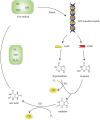Three Classes of Antioxidant Defense Systems and the Development of Postmenopausal Osteoporosis
- PMID: 35309045
- PMCID: PMC8927967
- DOI: 10.3389/fphys.2022.840293
Three Classes of Antioxidant Defense Systems and the Development of Postmenopausal Osteoporosis
Abstract
Osteoporosis is a common bone imbalance disease that threatens the health of postmenopausal women. Estrogen deficiency accelerates the aging of women. Oxidative stress damage is regarded as the main pathogenesis of postmenopausal osteoporosis. The accumulation of reactive oxygen species in the bone microenvironment plays a role in osteoblast and osteoclast apoptosis. Improving the oxidative state is essential for the prevention and treatment of postmenopausal osteoporosis. There are three classes of antioxidant defense systems in the body to eliminate free radicals and peroxides including antioxidant substances, antioxidant enzymes, and repair enzymes. In our review, we demonstrated the mechanism of antioxidants and their effect on bone metabolism in detail. We concluded that glutathione/oxidized glutathione (GSH/GSSG) conversion involved the PI3K/Akt-Nrf2/HO-1 signaling pathway and that the antioxidant enzyme-mediated mitochondrial apoptosis pathway of osteoblasts was necessary for the development of postmenopausal osteoporosis. Since the current therapeutic effects of targeting bone cells are not significant, improving the systemic peroxidation state and then regulating bone homeostasis will be a new method for the treatment of postmenopausal osteoporosis.
Keywords: GSH/GSSG; PI3K/AKT/Nrf2/HO-1; antioxidant system; oxidative stress; postmenopausal osteoporosis.
Copyright © 2022 Yang, Cao, Xue, Tao and Zhu.
Conflict of interest statement
The authors declare that the research was conducted in the absence of any commercial or financial relationships that could be construed as a potential conflict of interest.
Figures





Similar articles
-
Geraniin exerts cytoprotective effect against cellular oxidative stress by upregulation of Nrf2-mediated antioxidant enzyme expression via PI3K/AKT and ERK1/2 pathway.Biochim Biophys Acta. 2015 Sep;1850(9):1751-61. doi: 10.1016/j.bbagen.2015.04.010. Epub 2015 Apr 23. Biochim Biophys Acta. 2015. PMID: 25917210
-
Cytoprotective effect of Fufang Lurong Jiangu capsule against hydrogen peroxide-induced oxidative stress in bone marrow stromal cell-derived osteoblasts through the Nrf2/HO-1 signaling pathway.Biomed Pharmacother. 2020 Jan;121:109676. doi: 10.1016/j.biopha.2019.109676. Epub 2019 Nov 25. Biomed Pharmacother. 2020. PMID: 31810119
-
Metformin attenuates H2O2-induced osteoblast apoptosis by regulating SIRT3 via the PI3K/AKT pathway.Exp Ther Med. 2021 Nov;22(5):1316. doi: 10.3892/etm.2021.10751. Epub 2021 Sep 17. Exp Ther Med. 2021. PMID: 34630670 Free PMC article.
-
Oxidative stress: A common pathological state in a high-risk population for osteoporosis.Biomed Pharmacother. 2023 Jul;163:114834. doi: 10.1016/j.biopha.2023.114834. Epub 2023 May 8. Biomed Pharmacother. 2023. PMID: 37163779 Review.
-
Interaction between bone and immune cells: Implications for postmenopausal osteoporosis.Semin Cell Dev Biol. 2022 Mar;123:14-21. doi: 10.1016/j.semcdb.2021.05.014. Epub 2021 May 20. Semin Cell Dev Biol. 2022. PMID: 34024716 Review.
Cited by
-
Chondroitin sulfate alleviates osteoporosis caused by calcium deficiency by regulating lipid metabolism.Nutr Metab (Lond). 2023 Feb 6;20(1):6. doi: 10.1186/s12986-023-00726-3. Nutr Metab (Lond). 2023. PMID: 36747190 Free PMC article.
-
Nicotinamide enhances osteoblast differentiation through activation of the mitochondrial antioxidant defense system.Exp Mol Med. 2023 Jul;55(7):1531-1543. doi: 10.1038/s12276-023-01041-w. Epub 2023 Jul 18. Exp Mol Med. 2023. PMID: 37464093 Free PMC article.
-
The Role of Potential Oxidative Biomarkers in the Prognosis of Acute Ischemic Stroke and the Exploration of Antioxidants as Possible Preventive and Treatment Options.Int J Mol Sci. 2023 Mar 28;24(7):6389. doi: 10.3390/ijms24076389. Int J Mol Sci. 2023. PMID: 37047362 Free PMC article. Review.
-
Rational design of a dual-reactive probe for imaging the biogenesis of both H2S and GSH from l-Cys rather than d-Cys in live cells.RSC Chem Biol. 2022 May 17;3(7):848-852. doi: 10.1039/d2cb00105e. eCollection 2022 Jul 6. RSC Chem Biol. 2022. PMID: 35866170 Free PMC article.
-
Ex Vivo Osteoclastogenesis from Peripheral Blood Mononuclear Cells Is Unchanged in Adults with Phenylketonuria, Regardless of Dietary Compliance.Int J Mol Sci. 2025 Jun 16;26(12):5776. doi: 10.3390/ijms26125776. Int J Mol Sci. 2025. PMID: 40565238 Free PMC article.
References
-
- Alcendor R. R., Gao S., Zhai P., Zablocki D., Holle E., Yu X., et al. (2007). Sadoshima, Sirt1 regulates aging and resistance to oxidative stress in the heart. Circ. Res. 100 1512–1521. - PubMed
Publication types
LinkOut - more resources
Full Text Sources

